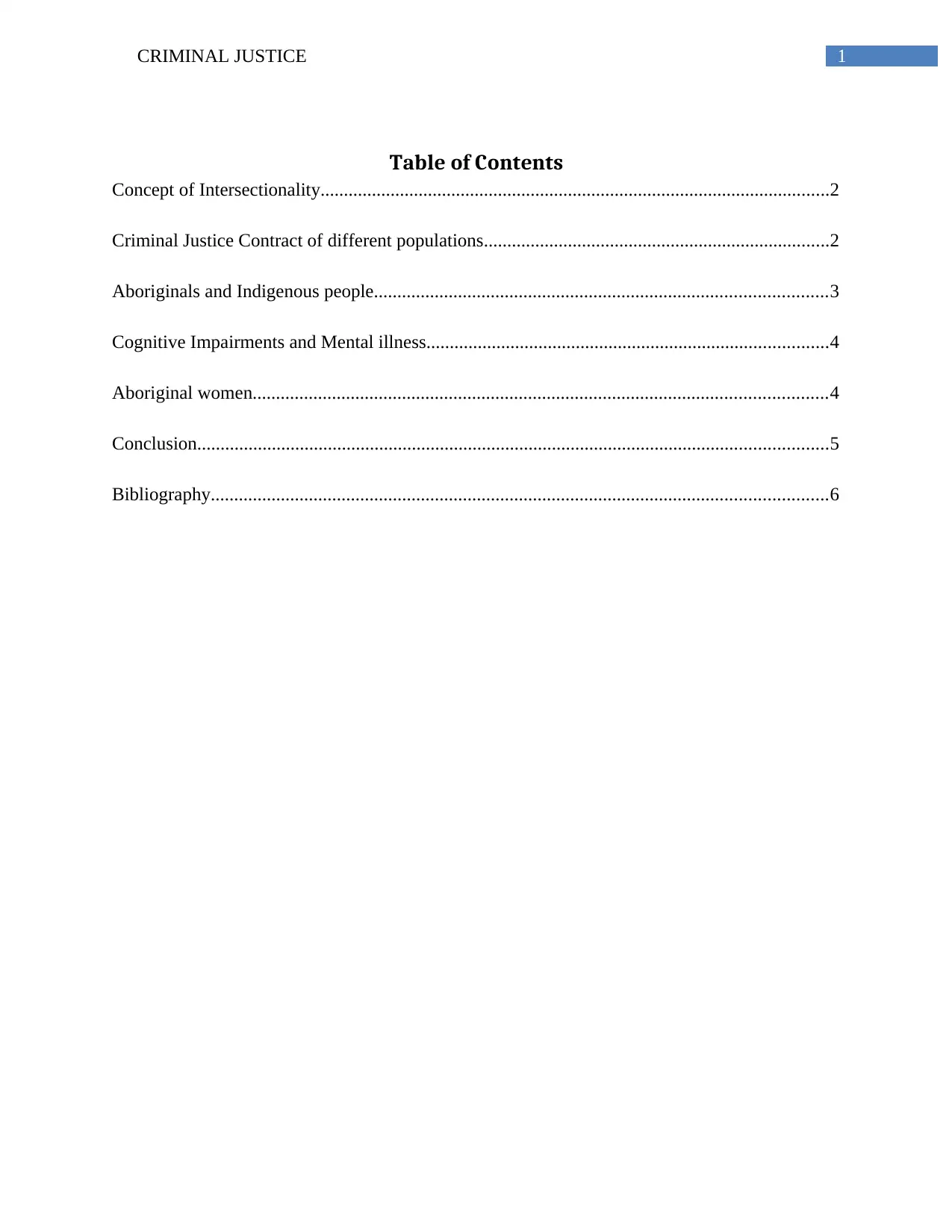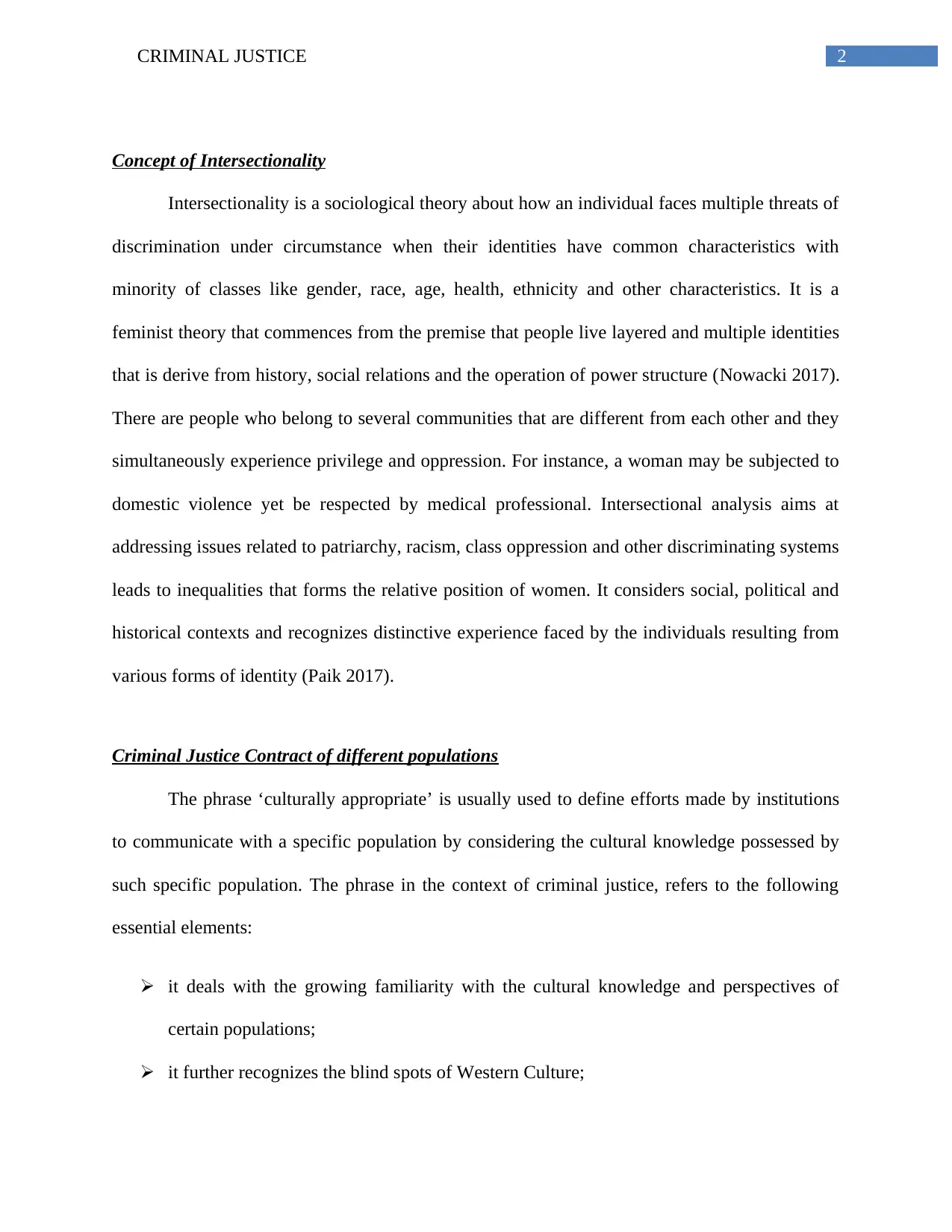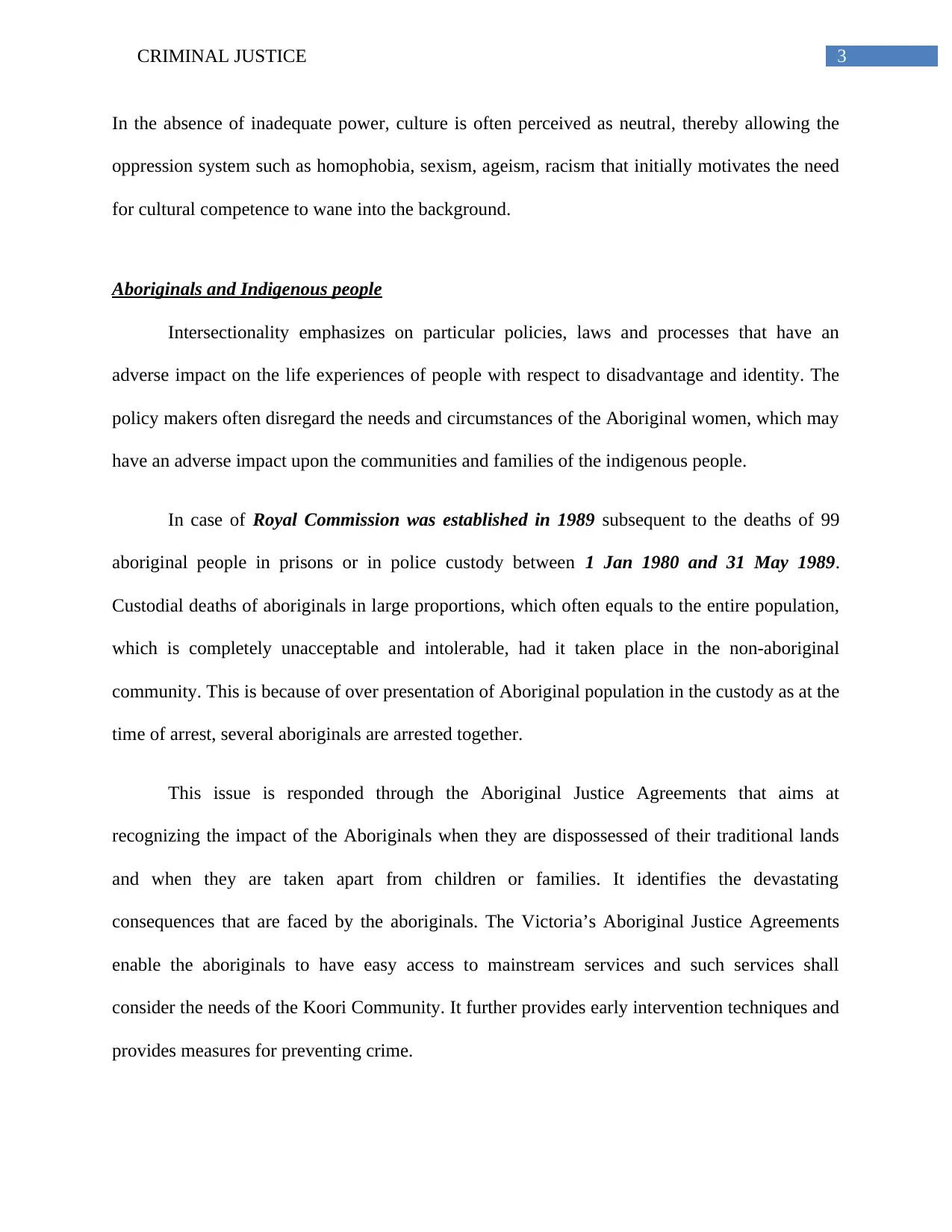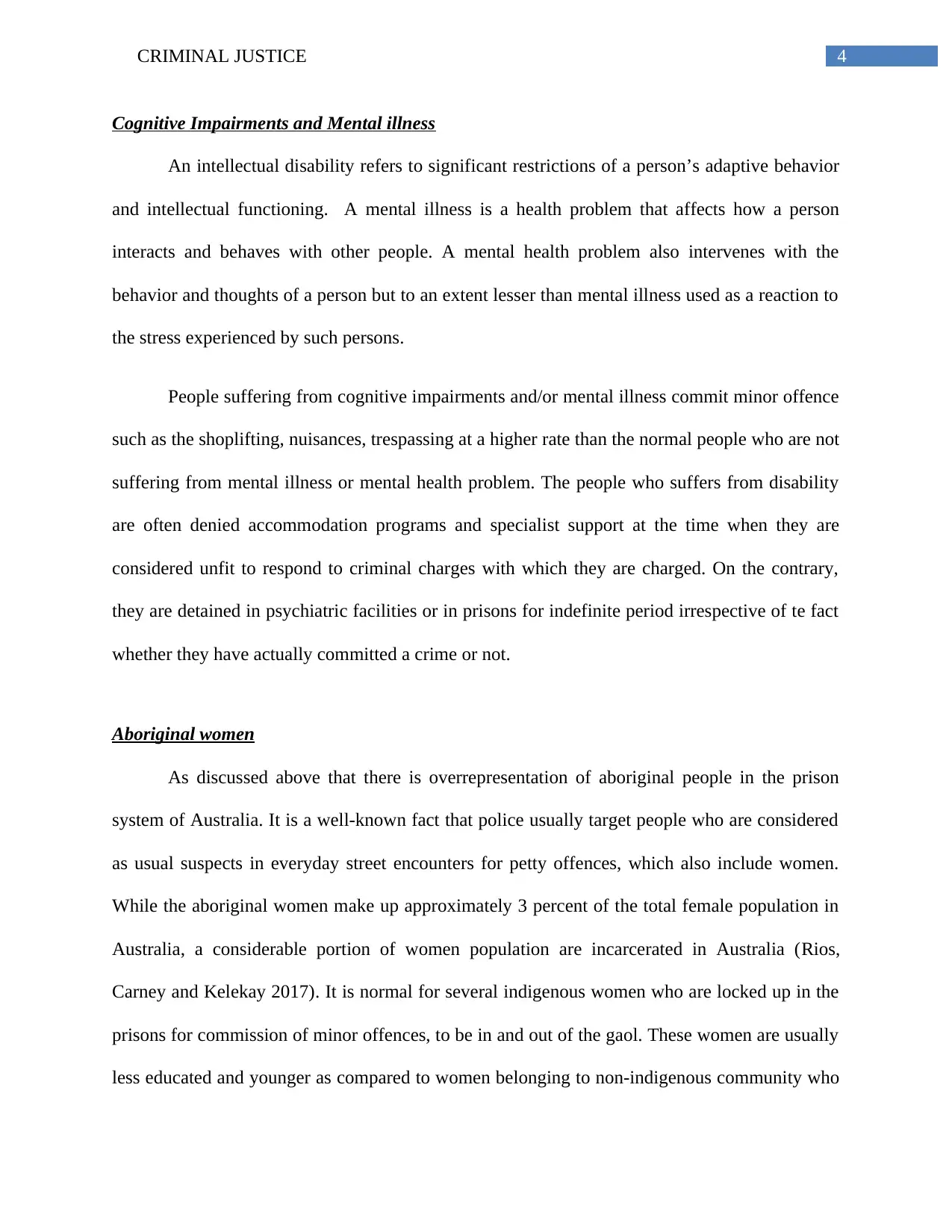Criminal Justice Essay: Intersectionality, Populations, and Policies
VerifiedAdded on 2020/05/01
|7
|1228
|151
Essay
AI Summary
This essay delves into the concept of intersectionality within the criminal justice system, exploring how various social identities intersect to create unique experiences of discrimination and disadvantage. It examines the application of intersectionality to different populations, including Aboriginal and Indigenous people, individuals with cognitive impairments and mental illnesses, and Aboriginal women. The essay highlights the impact of policies, laws, and processes on these vulnerable groups, emphasizing the overrepresentation of Aboriginal people in the criminal justice system and the challenges faced by those with mental health issues. It also discusses the concept of 'culturally appropriate' practices in criminal justice and argues for an intersectional approach to better understand and address systemic inequalities. The essay concludes by emphasizing the importance of recognizing the interconnectedness of various forms of oppression to create a fairer and more equitable justice system.

Running head: CRIMINAL JUSTICE
Criminal Justice
Name of the Student
Name of the University
Author Note
Criminal Justice
Name of the Student
Name of the University
Author Note
Paraphrase This Document
Need a fresh take? Get an instant paraphrase of this document with our AI Paraphraser

1CRIMINAL JUSTICE
Table of Contents
Concept of Intersectionality.............................................................................................................2
Criminal Justice Contract of different populations..........................................................................2
Aboriginals and Indigenous people.................................................................................................3
Cognitive Impairments and Mental illness......................................................................................4
Aboriginal women...........................................................................................................................4
Conclusion.......................................................................................................................................5
Bibliography....................................................................................................................................6
Table of Contents
Concept of Intersectionality.............................................................................................................2
Criminal Justice Contract of different populations..........................................................................2
Aboriginals and Indigenous people.................................................................................................3
Cognitive Impairments and Mental illness......................................................................................4
Aboriginal women...........................................................................................................................4
Conclusion.......................................................................................................................................5
Bibliography....................................................................................................................................6

2CRIMINAL JUSTICE
Concept of Intersectionality
Intersectionality is a sociological theory about how an individual faces multiple threats of
discrimination under circumstance when their identities have common characteristics with
minority of classes like gender, race, age, health, ethnicity and other characteristics. It is a
feminist theory that commences from the premise that people live layered and multiple identities
that is derive from history, social relations and the operation of power structure (Nowacki 2017).
There are people who belong to several communities that are different from each other and they
simultaneously experience privilege and oppression. For instance, a woman may be subjected to
domestic violence yet be respected by medical professional. Intersectional analysis aims at
addressing issues related to patriarchy, racism, class oppression and other discriminating systems
leads to inequalities that forms the relative position of women. It considers social, political and
historical contexts and recognizes distinctive experience faced by the individuals resulting from
various forms of identity (Paik 2017).
Criminal Justice Contract of different populations
The phrase ‘culturally appropriate’ is usually used to define efforts made by institutions
to communicate with a specific population by considering the cultural knowledge possessed by
such specific population. The phrase in the context of criminal justice, refers to the following
essential elements:
it deals with the growing familiarity with the cultural knowledge and perspectives of
certain populations;
it further recognizes the blind spots of Western Culture;
Concept of Intersectionality
Intersectionality is a sociological theory about how an individual faces multiple threats of
discrimination under circumstance when their identities have common characteristics with
minority of classes like gender, race, age, health, ethnicity and other characteristics. It is a
feminist theory that commences from the premise that people live layered and multiple identities
that is derive from history, social relations and the operation of power structure (Nowacki 2017).
There are people who belong to several communities that are different from each other and they
simultaneously experience privilege and oppression. For instance, a woman may be subjected to
domestic violence yet be respected by medical professional. Intersectional analysis aims at
addressing issues related to patriarchy, racism, class oppression and other discriminating systems
leads to inequalities that forms the relative position of women. It considers social, political and
historical contexts and recognizes distinctive experience faced by the individuals resulting from
various forms of identity (Paik 2017).
Criminal Justice Contract of different populations
The phrase ‘culturally appropriate’ is usually used to define efforts made by institutions
to communicate with a specific population by considering the cultural knowledge possessed by
such specific population. The phrase in the context of criminal justice, refers to the following
essential elements:
it deals with the growing familiarity with the cultural knowledge and perspectives of
certain populations;
it further recognizes the blind spots of Western Culture;
⊘ This is a preview!⊘
Do you want full access?
Subscribe today to unlock all pages.

Trusted by 1+ million students worldwide

3CRIMINAL JUSTICE
In the absence of inadequate power, culture is often perceived as neutral, thereby allowing the
oppression system such as homophobia, sexism, ageism, racism that initially motivates the need
for cultural competence to wane into the background.
Aboriginals and Indigenous people
Intersectionality emphasizes on particular policies, laws and processes that have an
adverse impact on the life experiences of people with respect to disadvantage and identity. The
policy makers often disregard the needs and circumstances of the Aboriginal women, which may
have an adverse impact upon the communities and families of the indigenous people.
In case of Royal Commission was established in 1989 subsequent to the deaths of 99
aboriginal people in prisons or in police custody between 1 Jan 1980 and 31 May 1989.
Custodial deaths of aboriginals in large proportions, which often equals to the entire population,
which is completely unacceptable and intolerable, had it taken place in the non-aboriginal
community. This is because of over presentation of Aboriginal population in the custody as at the
time of arrest, several aboriginals are arrested together.
This issue is responded through the Aboriginal Justice Agreements that aims at
recognizing the impact of the Aboriginals when they are dispossessed of their traditional lands
and when they are taken apart from children or families. It identifies the devastating
consequences that are faced by the aboriginals. The Victoria’s Aboriginal Justice Agreements
enable the aboriginals to have easy access to mainstream services and such services shall
consider the needs of the Koori Community. It further provides early intervention techniques and
provides measures for preventing crime.
In the absence of inadequate power, culture is often perceived as neutral, thereby allowing the
oppression system such as homophobia, sexism, ageism, racism that initially motivates the need
for cultural competence to wane into the background.
Aboriginals and Indigenous people
Intersectionality emphasizes on particular policies, laws and processes that have an
adverse impact on the life experiences of people with respect to disadvantage and identity. The
policy makers often disregard the needs and circumstances of the Aboriginal women, which may
have an adverse impact upon the communities and families of the indigenous people.
In case of Royal Commission was established in 1989 subsequent to the deaths of 99
aboriginal people in prisons or in police custody between 1 Jan 1980 and 31 May 1989.
Custodial deaths of aboriginals in large proportions, which often equals to the entire population,
which is completely unacceptable and intolerable, had it taken place in the non-aboriginal
community. This is because of over presentation of Aboriginal population in the custody as at the
time of arrest, several aboriginals are arrested together.
This issue is responded through the Aboriginal Justice Agreements that aims at
recognizing the impact of the Aboriginals when they are dispossessed of their traditional lands
and when they are taken apart from children or families. It identifies the devastating
consequences that are faced by the aboriginals. The Victoria’s Aboriginal Justice Agreements
enable the aboriginals to have easy access to mainstream services and such services shall
consider the needs of the Koori Community. It further provides early intervention techniques and
provides measures for preventing crime.
Paraphrase This Document
Need a fresh take? Get an instant paraphrase of this document with our AI Paraphraser

4CRIMINAL JUSTICE
Cognitive Impairments and Mental illness
An intellectual disability refers to significant restrictions of a person’s adaptive behavior
and intellectual functioning. A mental illness is a health problem that affects how a person
interacts and behaves with other people. A mental health problem also intervenes with the
behavior and thoughts of a person but to an extent lesser than mental illness used as a reaction to
the stress experienced by such persons.
People suffering from cognitive impairments and/or mental illness commit minor offence
such as the shoplifting, nuisances, trespassing at a higher rate than the normal people who are not
suffering from mental illness or mental health problem. The people who suffers from disability
are often denied accommodation programs and specialist support at the time when they are
considered unfit to respond to criminal charges with which they are charged. On the contrary,
they are detained in psychiatric facilities or in prisons for indefinite period irrespective of te fact
whether they have actually committed a crime or not.
Aboriginal women
As discussed above that there is overrepresentation of aboriginal people in the prison
system of Australia. It is a well-known fact that police usually target people who are considered
as usual suspects in everyday street encounters for petty offences, which also include women.
While the aboriginal women make up approximately 3 percent of the total female population in
Australia, a considerable portion of women population are incarcerated in Australia (Rios,
Carney and Kelekay 2017). It is normal for several indigenous women who are locked up in the
prisons for commission of minor offences, to be in and out of the gaol. These women are usually
less educated and younger as compared to women belonging to non-indigenous community who
Cognitive Impairments and Mental illness
An intellectual disability refers to significant restrictions of a person’s adaptive behavior
and intellectual functioning. A mental illness is a health problem that affects how a person
interacts and behaves with other people. A mental health problem also intervenes with the
behavior and thoughts of a person but to an extent lesser than mental illness used as a reaction to
the stress experienced by such persons.
People suffering from cognitive impairments and/or mental illness commit minor offence
such as the shoplifting, nuisances, trespassing at a higher rate than the normal people who are not
suffering from mental illness or mental health problem. The people who suffers from disability
are often denied accommodation programs and specialist support at the time when they are
considered unfit to respond to criminal charges with which they are charged. On the contrary,
they are detained in psychiatric facilities or in prisons for indefinite period irrespective of te fact
whether they have actually committed a crime or not.
Aboriginal women
As discussed above that there is overrepresentation of aboriginal people in the prison
system of Australia. It is a well-known fact that police usually target people who are considered
as usual suspects in everyday street encounters for petty offences, which also include women.
While the aboriginal women make up approximately 3 percent of the total female population in
Australia, a considerable portion of women population are incarcerated in Australia (Rios,
Carney and Kelekay 2017). It is normal for several indigenous women who are locked up in the
prisons for commission of minor offences, to be in and out of the gaol. These women are usually
less educated and younger as compared to women belonging to non-indigenous community who

5CRIMINAL JUSTICE
usually are employed or have children. In addition, the indigenous group often lacks housing and
support after releasing from prison, which further leads to reoffending. Consequently, they lack
access to the justice system and the prevalence of aboriginal custodial deaths results in lack of
trust in the policing system of the country.
Conclusion
However, overrepresentation of aboriginals and people with cognitive impairments and
mental illness experience the lowest level of services and their needs are disregarded. Criminal
justice systems and their institutions have become effective containers used for controlling and
capturing specific part of populations and deal with their problematic behavior. Further, public
policies have ignored the lives of indigenous women and people with cognitive impairment and
such public policies usually have an adverse impact upon the lives of such people.
The value in engaging criminal justice from an intersectional point of view is that it
enables to provide a better understanding of how several factors, which leads to oppression,
operate synergistically. This would enable to differentiate between the aspects of criminal justice
system that operates unfairly. The concept of intersectionality emphasizes on the particular
policies and procedures including social, legal, that has an adverse impact on the life of people
especially when such people have been subjected to inequality with respect to disadvantages and
their identity.
usually are employed or have children. In addition, the indigenous group often lacks housing and
support after releasing from prison, which further leads to reoffending. Consequently, they lack
access to the justice system and the prevalence of aboriginal custodial deaths results in lack of
trust in the policing system of the country.
Conclusion
However, overrepresentation of aboriginals and people with cognitive impairments and
mental illness experience the lowest level of services and their needs are disregarded. Criminal
justice systems and their institutions have become effective containers used for controlling and
capturing specific part of populations and deal with their problematic behavior. Further, public
policies have ignored the lives of indigenous women and people with cognitive impairment and
such public policies usually have an adverse impact upon the lives of such people.
The value in engaging criminal justice from an intersectional point of view is that it
enables to provide a better understanding of how several factors, which leads to oppression,
operate synergistically. This would enable to differentiate between the aspects of criminal justice
system that operates unfairly. The concept of intersectionality emphasizes on the particular
policies and procedures including social, legal, that has an adverse impact on the life of people
especially when such people have been subjected to inequality with respect to disadvantages and
their identity.
⊘ This is a preview!⊘
Do you want full access?
Subscribe today to unlock all pages.

Trusted by 1+ million students worldwide

6CRIMINAL JUSTICE
Bibliography
Nowacki, J.S., 2017. An intersectional approach to race/ethnicity, sex, and age disparity in
federal sentencing outcomes: An examination of policy across time periods. Criminology &
Criminal Justice, 17(1), pp.97-116.
Paik, L., 2017. Critical perspectives on intersectionality and criminology: Introduction.
Rios, V.M., Carney, N. and Kelekay, J., 2017. Ethnographies of Race, Crime, and Justice:
Toward a Sociological Double-Consciousness. Annual Review of Sociology, (0).
Bibliography
Nowacki, J.S., 2017. An intersectional approach to race/ethnicity, sex, and age disparity in
federal sentencing outcomes: An examination of policy across time periods. Criminology &
Criminal Justice, 17(1), pp.97-116.
Paik, L., 2017. Critical perspectives on intersectionality and criminology: Introduction.
Rios, V.M., Carney, N. and Kelekay, J., 2017. Ethnographies of Race, Crime, and Justice:
Toward a Sociological Double-Consciousness. Annual Review of Sociology, (0).
1 out of 7
Related Documents
Your All-in-One AI-Powered Toolkit for Academic Success.
+13062052269
info@desklib.com
Available 24*7 on WhatsApp / Email
![[object Object]](/_next/static/media/star-bottom.7253800d.svg)
Unlock your academic potential
Copyright © 2020–2025 A2Z Services. All Rights Reserved. Developed and managed by ZUCOL.




